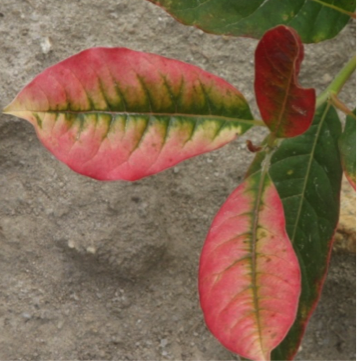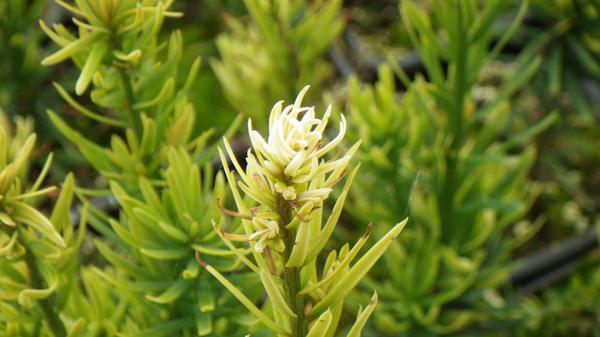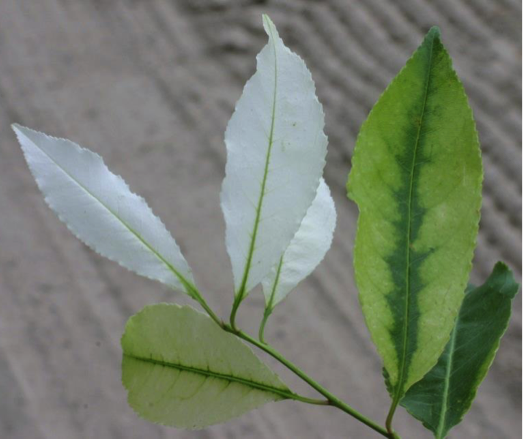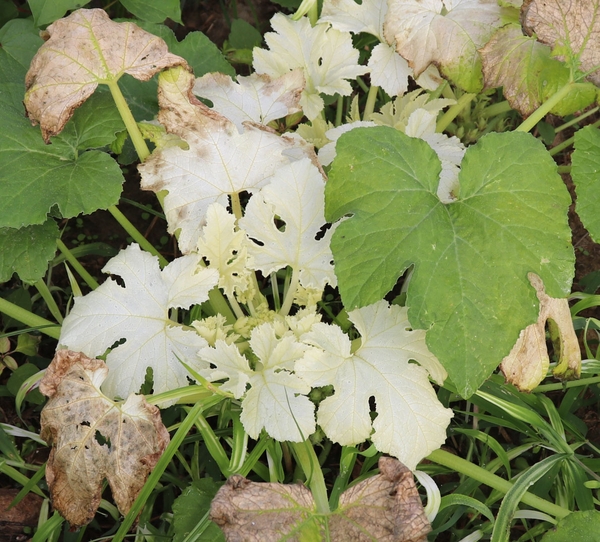Problem
Herbicide injury from carotenoid pigment inhibitors including clomazone, fluridone, isoxaflutole, mesotrione, norflurazon, and others.
Symptoms
- White, pale yellow to pale green foliage on new shoot tips and leaves of sensitive plants.
- Occasional pink to purple margins as pigment loss occurs.
- Affected tissues and growing points may become necrotic over time.
- Reduced growth.
- Over time, new growth may resume normal appearance resulting in green young growth but older white foliage.

Black gum plants exposed to clomazone vapor drift developed red foliage, with dark green main veins.
J. Neal CC BY-NC-SA 4.0

Clomazone vapor drift on grape. Pigment loss leads to white foliage, not yellow foliage.
J. Neal CC BY-NC-SA 4.0

Fluridone spray drift caused clorosis on muscadine grape - but did not cause total pigment loss as observed from clomazone vapor drift.
B. Lassiter CC BY-NC-SA 4.0

Look-a-like. This bleaching in dogfennel was caused by infection with the bacterium Psudomonas syringae pv. tagetes.
J. Neal CC BY-NC-SA 4.0

Look to the weeds for clues. This morningglory is showing interveinal chlorosis from fluridone spray drift.
B. Lassiter CC BY-NC-SA 4.0

Clomazine vapor drift injury symptoms will usually be visible in susceptible weeds present on field edges such as this pokeweed in the fence-row between the field crop treated with clomazone and the field where vapor drift damaged a susceptible crop.
J. Neal CC BY-NC-SA 4.0

Look-a-like: diquat spray drift on daylily results in bleached patches on foliage. Over time these patches will turn brown and necrotic.
J. Neal CC BY-NC-SA 4.0
Plant Entry and Symptom Expression
Most carotenoid pigment inhibitors are foliar applied and symplastically translocated throughout the plant. Some can be soil applied but must be incorporated to avoid volatilization or photodegradation. Soil applied carotenoid inhibitors (such as norflurazon and clomazone) enter the plant through the mesocotyl or hypocotyl of germinating seedlings and translocate symplastically. Clomazone has a high potential for vapor drift resulting in non-targeted plant bleaching. Carotenoid synthesis inhibition leads to loss of chlorophyll. Less sensitive plants, may resume normal growth within weeks of exposure.
Similar Problems
Carotenoid pigment inhibitor injury may be confused with symptoms from:
- Certain bacterial and fungal infections may cause bleaching of the growing points. For example, plants in the aster family can exhibit white growing points caused by Pseudomonas syringae pv. targets. This may be separated from carotenoid pigment inhibitor damage by the absence of symptoms on species from other plant families.
- Severe micronutrient deficiency, such as late stages of severe Fe deficiency may bleach tissues.
- Contact herbicides such as paraquat will bleach more rapidly than carotenoid pigment inhibitors and typically lead to rapid necrosis.
- Protoporphyrinogen oxidase (PPO) inhibitor such as acifluorfen shows tissue discoloration but bronzing appears rather than bleaching.
- Air pollution and car exhaust may cause white foliage. This can usually be distinguished by proximity to vehicle exhaust.
- Insect growth regulators have been shown to cause bleaching in sensitive greenhouse crops.
Herbicide Mode of Action Categories
|
DOXP synthase (clomazone) |
Phytoene desaturase (fluridone, norflurazone, & others) |
HPPD inhibition (mesotrione, topramezone, & others) |
|---|---|---|
| 13 | 12 | 27 |
Useful Resources
North Carolina Agricultural Chemicals Manual
Southern Region Small Fruit Consortium
Southeastern US Vegetable Crop Handbook
Weed Management in Nurseries, Landscapes & Christmas Trees Information Portal
Herbicide Handbook, Weed Science Society of America
Applied Weed Science: Including the Ecology and Management of Invasive Plants (3rd Edition), Merrill Ross & Carol Lembi, pages 165, 170-172.
Publication date: Sept. 10, 2015
Reviewed/Revised: March 26, 2025
N.C. Cooperative Extension prohibits discrimination and harassment regardless of age, color, disability, family and marital status, gender identity, national origin, political beliefs, race, religion, sex (including pregnancy), sexual orientation and veteran status.



